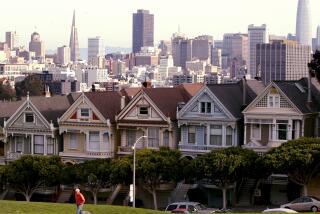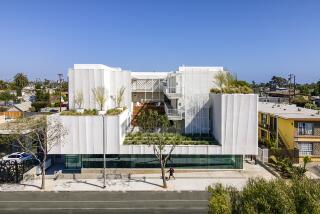Editorial: Turn golf courses into housing? We’re desperate enough that it should be on the table

- Share via
There are no easy ways to address the severe shortage of housing in California. Land is scarce, property costs are skyrocketing, and when developers do build, it’s generally easier to finance market-rate housing even though the most acute need is for affordable housing.
It’s a sign of how desperate our housing shortage is that lawmakers and some cities are even considering converting golf courses to housing. This should be a last resort given the paucity of open space in many communities. Empty shopping malls and other unused commercial space should be the first places to look. They already sit on large plots of land in the urban infrastructure. But the housing crisis requires that all options for locating building new units — parking lots, underutilized retail strips and dying malls — should be on the table.
One bill before the Legislature this year, Assembly Bill 1910, would incentivize local governments to convert some of their publicly owned golf courses into sites for affordable and market-rate housing. There are 960 golf courses in California, according to the National Golf Foundation, a trade association for the golf industry, but only about 200 are owned by local cities and counties.
Some municipal courses are financially struggling and have to be subsidized by the local government. That could make them candidates for conversion — especially in a community that would rather have housing and open space than a golf course. Under this bill, developers would be required to make at least 25% of the units affordable to low-income renters or buyers and set aside at least 15% of the land for publicly accessible open space.
There’s no question that golf courses are ideal, even idyllic, swaths of real estate as large as 100 acres or more. Even with the requirements for open space, that kind of land could hold a lot of housing.
But there are a lot of issues to keep in mind. Public golf courses are already offering something affordable — golf. The average price nationally for an 18-hole round of golf at a course open to the public was $38 last year, according to the National Golf Foundation. That includes all courses — public and privately owned — that are publicly accessible. That’s a deal compared with private clubs with expensive membership fees.
Numerous golfers of diverse backgrounds — in terms of income, ethnicity, age and gender — learned on public courses and still play there. Golf long ago stopped being the exclusive purview of rich white people. That’s partly because people from varied backgrounds found an accessible public course and a youth program or golf league they could join there.
Although the bill is supported by housing advocacy groups and builders of affordable housing (such as AIDS Healthcare Foundation), it is opposed by dozens of golf clubs, the National Golf Foundation, and the nonprofit Southern California Golf Assn.
No city is going to sell off popular or fabled public golf courses. Rancho Park in Los Angeles, Torrey Pines in San Diego come to mind. Nor is the author of the bill, Assembly member Cristina Garcia (D-Bell Gardens), trying to kill off public golf courses — particularly the ones that communities want to keep.
“Let’s have a conversation,” Garcia said. “Is this the best use of this land? Do we want to use this property in a different way?”
And that’s exactly what all elected officials should be doing — talking about how and where to create more housing. Whether or not Garcia’s bill is passed, it raises an important point that must be discussed. How can California possibly create the millions of units of housing that the state requires to keep people housed if we don’t look everywhere for available land? According to the state’s Regional Housing Needs Assessment numbers, Southern California alone must build more than 1.3 million units, mostly affordable, to fix the housing crisis in this region over the next seven years.
Another proposal that deserves discussion is a bill introduced this week by Assembly member Buffy Wicks (D-Oakland) that would cut red tape for developers looking to build affordable and mixed-income housing on properties zoned for office, retail and parking.
Lawmakers need as many tools in the toolbox as they can get to help further housing production. That’s why they passed Senate Bill 9 last year, which allows lot splits and duplexes in single-family housing zones. It won’t produce all the housing we need, but it will help.
Legislators need to be open-minded and aggressive about finding new locations for housing. Otherwise, there will never be enough built.
More to Read
A cure for the common opinion
Get thought-provoking perspectives with our weekly newsletter.
You may occasionally receive promotional content from the Los Angeles Times.










